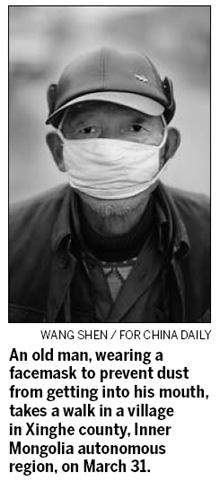BEIJING - A major source of sandstorms in North China's Inner Mongolia autonomous region, which was given a multimillion-yuan cleanup ahead of the 2008 Beijing Olympic Games, is once again dotted with polluting mining factories, according to a newspaper report.

The reopening of several mining factories in Xinghe county of Inner Mongolia may be one of the reasons for recent sandstorms that have blanketed northern China in dust, the Beijing News reported on Tuesday.
"There is certainly a connection between the mining industry and sandstorms, but how much sand is generated by mining is unknown," Chang Xing, head of Xinghe county Forestry Administration in Ulanqab, Inner Mongolia, told the newspaper.
Before the Olympic Games, Xinghe, as the closest sandstorm source to the capital city of Beijing, had been given great attention in the country's sandstorm control project, the report said.
The central government invested nearly 20 million yuan ($2.9 million) annually to contain the sand in 4,000 hectares of land in Xinghe since 2000. So far, about 130 million yuan has been invested in the project.
A report from the Ministry of Agriculture shows authorities have invested nearly 4 billion yuan in the sandstorm source control project of Beijing and Tianjin from 2000 to 2009.
Chang said in order to control sandstorms in the capital before the Games, the county authorities closed down all mining factories in Xinghe.
"In 2009, the factories could not reopen due to the gloomy market outlook, but many of them have restarted their businesses this year, as the mining industry is booming," he said.
In Huangtuyao village, south of Xinghe county, black lead production has become the main source of income for most villagers, with more than 3,800 tons produced every month, and consuming nearly 2 million tons of ore, the Beijing News reported.
The huge amount of waste from black lead extraction is emitted to nearby riverbeds, blocking rivers and turning farmlands into deserts, it said.
The environment is no longer suitable for living in the village. All of the 487 villagers have moved to other places and more than 533 hectares of farmland has been affected, the county government said in a report on March 2.
The report, quoting deputy county mayor Li Hai, said all effort and investment in the sandstorm control project over the past decade had proven futile and more funds are required.
Lack of funds and the prolonged drought have posed great difficulties in controlling sandstorms, he added.
The annual sand-control fund is only enough to buy tree seeds, and for Xinghe, with its annual revenue exceeding no more than 120 million yuan, labor and water are not affordable, he added.
This year a new 400-million-yuan program on black lead will start in the county, which is expected to pay 50 million yuan in taxes each year, the Beijing News reported.
Since 2000, Xinghe has planted more than 52,500 hectares of forests, according to statistics from the local government.
However, the severe drought since late 2009 has resulted in the death of 90 percent of newly planted trees, Chang said.
China Daily





